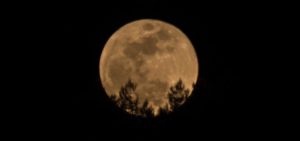Watch for the “Wolf Moon” this Friday, January 10. And if you’re in Asia, Africa, Europe, or Australia, you’ll get see the “Wolf Moon Eclipse”–a rare penumbral eclipse of the moon. See below or here for more info.
Feel free to howl all you want.
How, When And Where You Can See The ‘Wolf Moon Eclipse’, 2020’s First Of Thirteen Full Moons
Some of the world saw a “ring of fire” eclipse of the Sun on December 26, and exactly two weeks after some of it will see a “Wolf Moon Eclipse” as the moon drifts into Earth’s shadow.
That doesn’t include North America, but it will be visible from Europe, Africa, Asia and parts of Australia, where observers under clear skies will witness a rather odd-looking full moon on Friday, January 10, 2020.
In North and South America, however, the spectacle on offer a few hours later is the appearance of January’s full “Wolf Moon,” a beautiful full moon that will be best seen at moonrise and moonset.
Here’s everything you need to know about the “Wolf Moon Eclipse,” the first of full moon of the decade, and the deepest lunar eclipse of 2020.
When is January’s full Moon?
The moon will be 100% illuminated at precisely 7:21 p.m. Universal Time on January 10, which is 2:21 p.m. EST and 11:21 a.m. PST. That’s the daylight hours in North and South America, so it will be impossible for anyone there to see the “Wolf Moon Eclipse,” though dusk on Friday will be an excellent time to watch the full moon rise in the west close to sunset.
What those in Asia, Australia, Europe and Africa will see is a rare a penumbral eclipse of the moon.
What is a penumbral lunar eclipse?
It’s actually not that rare, at least, not in 2020, when there are four penumbral lunar eclipses, two of which North Americans will be able to see. More on that below. A penumbral lunar eclipse occurs when the moon drifts into Earth’s penumbra (outer shadow).
It’s different to a total lunar eclipse. During a total lunar eclipse—often called a “blood moon”—the moon enters the Earth’s central shadow, its umbra. It then turns reddish because th only light moving to the lunar surface is being filtered by Earth’s atmosphere, which is very good at scattering blue, but not red, light. Instead, during a penumbral lunar eclipse, the moon simply loses a lot of brightness, in this case in its southern region. It’s a really odd sight to be able to look at a full moon when it’s high in the sky, though it’s best appreciated by taking photos of the full moon at the peak of the eclipse, then post-eclipse, to really appreciate the effect of Earth’s shadow.
How, when and where to see the ‘Wolf Moon Eclipse’
This depends on where you are. For anyone wanting to see the full moon at its best, just be sure to look at moonset (around sunrise) and moonset (around sunset) on January 10. However, if you’re in Asia, Australia, Europe or Africa, know that the penumbral lunar eclipse begins at 5:07 p.m. Universal Time and will be at “maximum eclipse” at 7:10 p.m. Universal Time. You can convert for your own location/time zone here, or consult this page, but here are a few times for “maximum eclipse” of the “Wolf Moon” from a select few cities in the eclipse-zone, when a dark shadow will move across the bottom half of the Moon:
- London: 7:10 p.m. on January 10
- Mainland Europe: 8:10 p.m. on January 10
- Cairo: 9:10 p.m. on January 10
- Moscow: 10:10 p.m. on January 10
- Dubai: 11:10:02 p.m. on January 10
- New Delhi: 12:40 a.m. on January 11
- Shanghai: 3:10 a.m. on January 11
- Perth: 3:10 a.m. on January 11
Note that these are the times for maximum eclipse; the event as a whole takes place over about four hours. It’s Western Europe that’s best-placed for those wanting to watch the “Wolf Moon” rise in the east followed quickly by the beginning of the penumbral lunar eclipse.
When to observe the full moonrise from North America
Although the penumbral lunar eclipse will have ceased before moonrise in North and South Americans, the sight of the “Wolf Moon” rising in the east will nevertheless be a beautiful sight. That will happen at 4:45 p.m. EST in New York and at 5:10 p.m. PST in Los Angeles very close to sunset.
Why are there thirteen full moons in 2020?
Lunar months are 29 days long. Most months have longer than 29 days, so the date of the full moon drifts to be sooner in successive months. Inevitably there comes a time when there’s a full moon on the first and last day of the month, something that in 2020 happens in October. The second full moon of that month, on October 31, 2020, will therefore be a “blue moon”, so 2020 will have 13 full moons in total.
When are the next lunar eclipses in Europe and the North America?
There are three more penumbral lunar eclipses in 2020, though none are as deep as the “Wolf Moon Eclipse:”
- June 5, 2020: Asia, Africa and Australia
- July 5, 2020: South America, North America and Africa
- November 29, 2020: North and South America, Australia and East Asia
